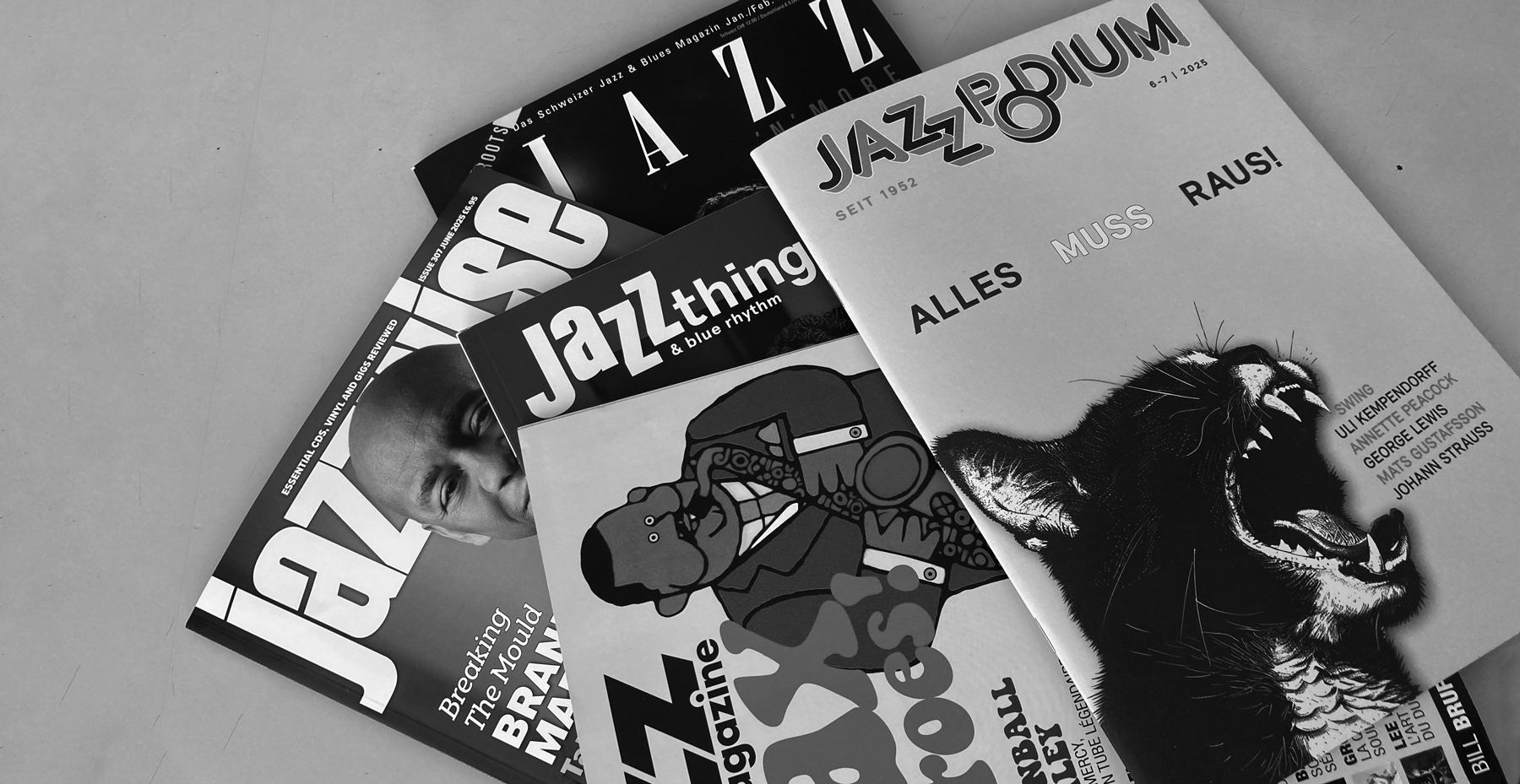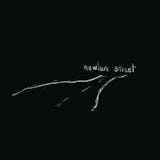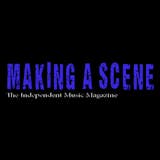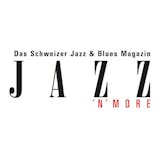
All Reviews
Music journalism is under threat — and those who write about experimental and improvised music are a rare and vital breed. We collect and showcase these reviews to honour their work and help you dive deeper into the sound.
Although the "pioneer" label may reflect her role through the decades, it does not completely convey the importance of late pianist Irène Schweizer's contributions to modern art. Aside from the impact that the Swiss pianist's music has had on certain players (including, in this reviewer's case, an enhanced perspective on contrapuntal extemporization and the capacity to stay composed across turbulence), the expressions that arise when I think of Schweizer's music, or observe her gaze up close, are "coherence" and "articulation."
Schweizer's oblique, unpremeditated movements on the keyboard were directed by a thorough awareness of her position within a sonic continuum. Her phrasing always revealed reference points, veritable "acoustic beacons" to assist us in decoding the message. And, last but not least, that scintillating inventiveness — comprising a mastery of extended techniques and preparations — was truly uncommon.
Given all the reasons stated above and beyond, what is offered here by Intakt —; Schweizer's enduring "home" during most of her career — should be embraced with genuine excitement. Irène's Hot Four serves as the audio documentation of the inaugural act by a group of exceptional musicians. Along with the nominal leader, the ensemble is shaped by Rüdiger Carl on accordion, sax and clarinet, Johnny Dyani on double bass and voice, and Han Bennink on drums, percussion and megaphone. Each artist warrants an individual story, of course, but what is significant in this situation is the outcome of their instrumental (and, on occasion, theatrical) interaction for the listener's advantage. This set, taped by Radio SRF at the 1981 edition of Internationales Jazzfestival Zürich, was praised by local media as a peak of the event. Upon listening to the recording, one cannot help but agree with that assessment, joining the audience's enthusiastic response at the end of each piece in the time machine of the mind.
In spite of the fact that this was their introductory concert, the participants sound as if they had rehearsed together since childhood, effortlessly seeking, finding, prompting and reacting through superb improvisational skills. The high caliber of the interplay and the diverse sensations of tension and release it generates — from fast-paced, ever-changing superimpositions to circus comedy, from anarchic clatter to the clever organization of spontaneous themes — could be discussed for ages without fully grasping the kind of creative spark that ignited the inner dynamics of these beings, immersed in their own "stage reality" and revitalized by the energy they shared with one another. The gift for us is an exhilarating series of genre-jumping scenarios where Schweizer, Dyani, Carl and Bennink function as distinct leaders who have no need for a negotiating table, the term "compromise" seemingly not appealing to any of them. Accordingly, the distinctiveness of the single voices becomes a combination of twists and turns that surpasses styles, norms and tired ideals, in the interest of a "right now" that conceals expectations for a utopian future.
This is an unquestionable must, from which newcomers might start to delve into Schweizer's recorded history. Collaborations like this, alongside solo piano milestones such as 1996's Many And One Direction, also on Intakt, illustrate the vast expressive range of this empathetic, tenacious, quick-witted woman. Should someone genuinely wish to engage in serious study, do complement these and any additional resources with the outstanding book by Christian Broecking, This Uncontainable Feeling of Freedom: Irène Schweizer — European Jazz and the Politics of Improvisation, which includes, among other features, a photo of Cecil Taylor — indeed — intently observing a Schweizer live performance from backstage. Nothing more needs to be said.
https://www.squidco.com/cgi-bin/news/newsView.cgi?newsID=2950
La memoria viva struttura e indirizza il jazz: materiali sempre riplasmabili, ognuno con la sua fetta di storia in evidenza. Il pianista cubano Aruán Ortiz in Creole Renaissance riflette sul Movimento della Negritudine, nato nel 1935 con il giornale Lo Studente Nero; sceglie di farlo con un'austera formula per piano solo in cui sbalzano fuori i silenzi e i contrasti abissali di registro tra mano sinistra e destra, mettendo in conto Taylor come Schoenberg, Messiaen e Monk. Per Intakt, come le altre due segnalazioni. Il batterista visionario Jim Black torna con i suoi Schrimps con Better You Don't. II suo drumming disarticolato e possente, all'accorrenza anche implacabilmente binario, regge, con il basso acustico di Felix Henkelhausen, il fremito delle interazioni del contralto di Asger Nissen, col tenore di Julius Gawlik. Gregg Belisle-Chi in Slow Crawl: Performing the Music of Tim Berne Vol. 2 torna a esplorare, col solo ausilio delle sue corde acustiche, le geniali composizioni del sassofonista suo mentore e collaboratore da tempo, in duo e in trio. Labirintico e magico.
Between a trip to China last weekend and my immersion in Jazzfest Berlin this past weekend I wasn’t able to publish this newsletter as scheduled, yesterday. I’m half-surprised I’m doing it now, to be honest. Music has the ability to elasticize time, but I don’t, and time has been in very short supply of late. My current condition also explains why many of this week’s entries are shorter than usual—which will likely please some readers.
Silke Eberhard Returns to Her Trio, but She’s Not Thinking Small
In the last few years alto saxophonist Silke Eberhard has leaned in to writing and arranging music for her versatile tentet Potsa Lotsa XL, collaborating with Henry Threadgill’s Zooid, tuba player José Davila, and gayaguem player Youjin Sung, and exploring procedures more commonly associated with contemporary classical music. She seems to move from strength to strength, steadily expanding her practice in all directions. All of that growth has been impressive, but sometimes it diminishes her excellence as an improviser, an ability that takes center stage in her long-running trio with bassist Jan Roder and drummer Kay Lübke, which released Being-a-Ning (Intakt), its fifth album, earlier this year. While the music remains tethered to post-bop fundamentals, it’s the freest, most exploratory music I’ve ever heard from the group.
Kevin Whitehead’s typically astute liner note essay mentions Eberhard’s interest in the intervallic system that Threadgill developed for his group Zooid. While she hasn’t embraced that model here, the experience does seem to have impacted the way she thinks about music. The album title is a clear nod to Thelonious Monk, but it also refers to a string of titles she’s used for her last albums that include the word “being,” which suggests a larger devotion to existing in the moment. These ten new compositions are more jagged, angular, and surprising, which you can sense right out of the gate on “What’s in Your Bag,” a Braxton-esque gem which further illustrates a deep connection to Chicago jazz history. The genesis of Potsa Lotsa XL, for example, emerged from a project she had with Chicago in 2017. On the other hand, the trio takes on all sorts of new tacks here, from the needling, tightly-coiled “Sao,” a showpiece for Lübke, or the infectiously limber “New Dance,” where the elastic rhythm section ride the driving group with an impressive snap, expanded with some subtle electronic flourishes, giving Eberhard wide berth in her extended solo. Still, no matter how much the trio experiments and leans into freedom, it maintains an inexorable connection to swing, and there’s no missing those connections on the title track, which like the Monk piece it’s named after, is based on rhythm changes. Check it out below.
The trio performs as part of the Jazz am Helmholtzplatz series on Thursday, November 6. Eberhard also plays on Wednesday, November 5 with a new quartet called Endophyte with Lübke, Davila, and Potsa Lotsa XL trumpeter Nikolaus Neuser at Münzenberg Saal in the building that houses the offices of Wolke Verlag and FMP Records (address below in recommended shows list).
https://petermargasak.substack.com/p/berlin-non-stop?triedRedirect=true
Szwajcarska pianistka i kompozytorka Sylvie Courvoisier od ponad dwóch dekad jest jedną z najważniejszych postaci współczesnego jazzu i znajduje się w samym centrum nowojorskiej sceny muzycznej. Właśnie otrzymała prestiżową Szwajcarską Nagrodę Główną Muzyki 2025, a teraz prezentuje swój najnowszy album nagrany w duecie z legendarnym Wadadą Leo Smithem. Album „Angel Falls” jest to kontynuacja koncepcji znanych już w solowego albumu „To Be Other-Wise” oraz nastrojowego, wielowarstwowego albumu sekstetu „Chimaera”.
Sylvie Courvoisier jest pianistką, kompozytorką oraz znakomitą improwizatorką. Urodzona w Lozannie w Szwajcarii, w 1998 roku przeprowadziła się do Nowego Jorku. Koncertowała i nagrywała z Johnem Zornem, Wadadą Leo Smithem, Joey’em Baronem, Ellery Eskelinem, Natem Wooley’em, Fredem Frithem, Yusefem Lateefem, Timem Berne, Joëlle Léandre, Erikiem Friedlanderem, Butchem Morrisem, Tony’m Oxley’em, Herbem Robertsonem, Tomaszem Stańko oraz z Ikue Mori i Susie Ibarra (w trio Mephista). Pianistka zrealizowała kilkanaście autorskich albumów oraz kilkadziesiąt jako artystka zapraszana do projektów innych muzyków. Jej nagrania znajdują się zarówno w katalogu ECM Records, Tzadik Records (Johna Zorna), jak i szwajcarskiej oficyny Intakt Records. Jest najciekawsze sesje to m.in. „Time Gone Out” – duet z Markiem Feldmanem, „D’Agala Sylvie Courvoisier Trio”, „Crop Circles”- duet z Mary Halvorson, „Miller’s Tale”- kolektywny kwartet z Evanem Parkerem, Ikue Mori i Markiem Feldmanem, „Salt Task” – trio z Chrisem Corsano i Natem Wooley’em. Od 1998 roku Sylvie Courvoisier regularnie występuje solo lub w duecie ze skrzypkiem (i mężem) Mark’em Feldmanem. Od 2013 roku jest liderem własnego Trio z Drew Gressem (kontrabas) i Kenny’m Wollesenem (instrumenty perkusyjne). Album „D’Agala Sylvie Courvoisier Trio” został doceniony przez krytyków i znalazł się na listach najlepszych albumów roku New York Times i Los Angeles Times. Pianistka jest także współliderem Sylvie Courvoisier/Mark Feldman Quartet ( z Drew Gressem i Tomem Rainey’em), VWCR Quartet (z Kenem Vandermarkem, Natem Wooley’em i Tomem Rainey’em) oraz TISM Quartet z Tomem Raineyem, Ingrid Laubrock i Markiem Feldmanem. Od 2017 roku gra także w duecie z Mary Halvorson a od 2000 roku jest członkiemMephista– improwizującego kolektywnego trio z Ikue Mori i Susie Ibarra. Sylvie Courvoisier regularnie występuje w wielu zespołach i projektach kompozytorskich Johna Zorna, takich jak, „Cobra and the Masada” oraz „Bagatelle Marathon”. Od 2010 roku jest pianistką i kompozytorką w projekcie „La Curva” tancerza flamenco Israela Galvana, z którym zrealizowała ( w 2018 roku) „Cast-aNet” – z Evanem Parkerem, Markem Feldmanem i Ikue Mori a w 2020 roku „La Consagración de la primavera” z Cory’m Smythem, wykonując „Święto wiosny” Igora Stravinky’ego i autorskie „Spectro” na dwa fortepiany i taniec.
Legendarny Ishmael Wadada Leo Smith jest jedną z najbarwniejszych i najważniejszych postaci improwizowanego jazzu. Ostatnie lata to najpiękniejszy okres w życiu charyzmatycznego artysty, który jest ozdobą najważniejszych festiwali, realizuje ciekawe projekty oraz nagrywa albumy dla prestiżowych oficyn ( od ECM po Intakt i TUMI). 83-letni Wadada Leo Smith to artysta niezwykle aktywny, współautor sukcesów i wspaniałych nagrań Mariona Browna, Anthony’ego Braxtona, koncertów z Donem Cherrym, Cecil Taylorem, Lesterem Bowiem, Johnem Zornem, Charliem Hadenem, Jack DeJohnette, Billem Laswellem. W swoim dorobku ma ponad 60 albumów nagranych dla najbardziej liczących się wytwórni. Większość sesji to rodzaj specyficznych suit i utworów budowanch impresjami i skojarzeniami z muzyką wielkich free-jazzu oraz nowoczesnych, harmolodycznych improwizacji.
Jak odległa jest dzisiaj muzyka Wadada Leo Smith’a od harmolodic-jazzu Colemana trudno definitywnie określić. Zdaje się, że rozgrywa się także i teraz w blasku brzmień albumu „Angel Falls” bowiem Wadada Leo Smith to jedna z najbarwniejszych i najważniejszych postaci improwizowanego jazzu. Jest niezwykle aktywnym muzykiem chicagowskiego AACM, improwizatorem, kompozytorem, trębaczem, multiinstrumentalistą, etnomuzykologiem, działaczem na rzecz praw człowieka Ostatnia lata to najpiękniejszy okres w życiu kontrowersyjnego artysty: jest ozdobą najważniejszych festiwalu, realizuje ciekawe projekty oraz nagrywa albumy dla prestiżowych oficyn. Ten wyjątkowy muzyk, zawsze podąża za duchem czasu, celebrując muzyczną różnorodność i kreatywność, a także sprzeciwiając się wszelkim etykietkom. W ciągu ostatnich 50 lat przyczynił się do rozwoju muzyki w różnych kontekstach. Album „Angel Falls” emanuje magią muzycznej wolności, zdumiewającą bezpośredniością i urzeka olśniewającym zmysłem architektury dźwięku.
„ Angel Falls” jest sesją, w której arcymistrz Wadada Leo Smith, wspomagany i podżegany przez żarliwą ciekawość Sylvie Courvoisier angażuje słuchacza jako aktywnego twórcę prawdziwie błogiej, pięknej muzyki. To magia, która nie zdarza się czę...
Es gibt mehrere Hunde in den Titeln dieses Albums.
Einen „Space Poodle", dann das komplette „Flying Mega Doghouse", und zum Einstieg „Chilling with the Dogs".
Manchmal geht es ganz schön wild zu, und selten ahnt man lange vorher, was einen gleich erwartet. Gitarrist Dave Gisler ist stilistisch wenig festgelegt, aber alles, was er macht, hat Sinn und folgt intensiven Klangvorstellungen. Mit Raffaele Bossard (b) und Lionel Friedli (dr) arbeitet er seit 2017 im Trio, entsprechend dicht beieinander kommt die Gruppe daher.
Und das will etwas heißen bei Gislers Polystilistik und bei lauter live aufgenommenen Stücken. In den Liner Notes werden als Vergleichsgröße die guten alten Cream angeführt (eine Jazz-Band, sagte Jack Bruce mal, aber das hätten sie Eric Clapton nie verraten): ein Vergleich, der wenigstens die eigenartige Verdichtung dreier profilierter Individualitäten benennt. Manchmal legt Gisler auch mit Verzerrer und anderem Schnickschnack los, allerdings klingt er dann eher virtuos facettenreich wie McLaughlin. Aber alles nur vorübergehend.
Es macht große Freude, diesem wunderbar eingespielten Trio zuzuhören, wie es Energieverausgabung und luftige Spaziergangsstrecken nahtlos zueinander fügt, Dichte und Entspannung wechselt, Räume eröffnet, ins Weite weist und dann wieder dicke Bretter bohrt und an Mauern baut. Dabei kommt es nicht zu Schroffheiten und Brüchen. Alles bleibt an seinem Platz in der durchs Unendliche fliegenden Hundehütte.
As Borderlands, double bassist Stephan Crump, drummer Eric McPherson and pianist Kris Davis developed an astonishing strain of improvised music - a series of extended excursions where heightened interplay and a devotion to timbre and colour eclipsed the group's heady command of melody and harmony.
When the group took a hiatus in 2024, the bassist and drummer wanted to build on the connection they forged together, so they decided to enlist alto saxophonist Darius Jones, whose instrument and temperament guaranteed a different sound, but whose commitment to exploration would enable their process to keep growing. Crump and McPherson continue to forge a mix of abstract structures and indirect propulsion, leaning into instinct more than groove, but the linear quality of Jones's playing can't help but change the approach. It's all still improvised on the spot, but where Davis added additional layers to the edifice, Jones rides across or burrows into it, depending on the given moment.
Otherlands Trio move in and out of elusive patterns. Over 16 breathless minutes the opening piece "Metamorpheme" latches on to fleeting grooves, only to collapse them as suddenly as they appear, not as an act of destruction but as a process of reinvention. What may seem like a Crump bass solo over McPherson's inventive cymbal play is really just another duo passage with shifting instrumental emphasis.
Nobody in the trio is ever subservient, even if they do step back. Toward the end of the piece Jones locks into a corkscrewing riff, perpetually stoked and cajoled by the rhythm section, who elsewhere set a rhythmic table for his wide open blowing. "Diadromous" does maintain an irresistible groove for its duration, with Jones crafting lines that burn into the rhythm like etched glass. It may seem like free jazz, but ultimately Otherlands Trio thrives because the members draw so openly on
lifelong experience and learning, surrendering self in pursuit of a truly collective conception.
Incredibly, trumpeter Wadada Leo Smith is 84 this year. I caught him recently in a duo with Swiss pianist Sylvie Courvoisier at Vilnius Jazz on his final European tour- an amazing gig which is fully reflected in this superb release by lntakt. The two are partners in the fullest musical sense - no comping, no showboating, just pure improvisational brilliance.
Smith emerged in the late 1960s, as an original voice on trumpet alongside Anthony Braxton. Later he was a central figure in the AACM. I recall his inspirational thoughts in a pamphlet from that time, where he offered what amounted to a Romantic ideal of improvisation, with the musical idea fixed in advance of its expression. Sylvie Courvoisier was born in Lausanne, Switzerland, and moved to New York in the 1990s, becoming a force on John Zorn's Downtown scene. A highly individual stylist, she met Smith during a 2017 concert curated by Zorn, and the trumpeter appeared on Courvoisier's Chimaera in 2023, alongside Christian Fennesz and others.
On Angel Falls, Courvoisier and Smith respectively alter their sound via piano preparations or trumpet mutes. Smith belongs to the contemporary jazz trumpet tradition that flows from Miles Davis's melancholic approach, and his tone is beautifully cloudy when muted. On open trumpet he's full and clear, with no loss of power into his eighties. The programmes of concert and album overlap. "Naomi Peak" features furious pummelling and glissandos. "Whispering Images" is entropic, almost nihilistic. The long, dramatic and haunting title track is beautifully paced. The album closes with the ethereal "Kairos", featuring luxuriant piano preparations and voicings that gesture towards Messiaen.
Like his contemporary Braxton, Wadada Leo Smith is prolific. I find his jazz work more impressive than his classical compositions. As a jazz soloist his playing is rich, expressive and lyrical, and the magical extended dialogue of Angel Falls is album of the year material.
Trumpeter Wadada Leo Smith and pianist Sylvie Courvoisier first played together at a concert organised by John Zorn in 2017 and have collaborated regularly since then. But this is the first time they have recorded together as a duo, a format Smith loves and regularly returns to. It was Smith who suggested they record together, Courvoisier who asked that they avoid charts. What resulted are eight tracks of stunning immediacy, a sense that sonic architecture is being discovered anew. Courvoisier remarks that, starting at noon, “We just played right through exactly the order of the CD, and exactly the amount of music on the CD, with no edits. We probably did that in two hours.” Recorded and mixed on the same day, everything was done and dusted by 5pm.
That sense of immediacy permeates every one of the eight pieces, all given their titles during a joint listen to the playback. Throughout, Smith is elegant and rarely hurried in his delivery, performing with controlled emotion whether in annunciatory fanfares or more subtle lines, sometimes with an open horn, often muted. Courvoisier is consistently inventive and unpredictable, delivering both rumbling piano rolls and a snatch of boogie-woogie, percussive interludes and romantic passages. She brings a childlike sense of wonder to the music, a joyful and spontaneous immediacy of creation, in real time. Together as Courvoisier says, “We’re like kids discovering things. … Basically, I try to erase myself and try to make him sound great.” But actually, they both sound great, complementing each other without comping, showboating or grandstanding. I hope these two fine musicians work together again soon.
https://jazzjournal.co.uk/2025/10/31/reviewed-wadada-leo-smith-sylvie-courvoisier-brigitte-beraha-ruby-rushton//
Né en 1979 en Suisse, Christoph Irniger est un saxophoniste, compositeur et leader dans diverses formations au sein desquelles il a développé un style plutôt innovant et contemporain dans l’univers du jazz. Pour cette performance en public, donnée en 2023 au Red Horn District, Bad Meinberg en Allemagne, il s’associe les services de plusieurs comparses. On notera les présences de Stefan Aeby, Daven Gisler, Raffaele Bossard et de Michael Stulz. Tout ce petit monde pour effectivement concevoir un répertoire contemporain, voire expérimental, où l’improvisation semble omniprésente à travers des passages techniques et pointus. S’alternent des passages mélodiques et fluides, où le saxophone a une place de choix, et des moments plus aventureux, où l’on découvre effectivement une musique innovante et créative. A travers une dominance jazz, on découvrira un beau passage bluesy à la guitare, ainsi qu’un chouette passage technique à la batterie, au sein d’une première composition s’appelant étrangement « Hendrix » ! Notons qu’entre les morceaux, on entendra les applaudissements du public, sinon pour le second morceau, on assistera à une plongée au sein d’un travail expérimental fait de sons épars, au travers duquel filtre un travail plus cadré au piano et au saxophone. Une alchimie atypique, qui pourrait surprendre certains, puisque se côtoient au sein d’une même composition un jeu classique et un jeu improvisé. Côté aventureux et innovant, on décèlera également des passages plus intimistes où tout est joué avec délicatesse et où il faudra tendre une oreille attentive. Au final, des lignes classiques s’enchevêtrent au sein d’un laboratoire sonore où l’innovation et l’improvisation sont de mise. Un résultat créatif !
https://jazzmania.be/christoph-irniger-pilgrim-human-intelligence/
Longue de plusieurs années au sein de la scène new-yorkaise, la collaboration entre Sylvie Courvoisier et Wadada Leo Smith s’est concrétisée dernièrement autour de deux disques. Smith intervient au sein du quartet qui interprète Chimerae paru en 2023 et qui constitue d’ores et déjà à coup sûr un des sommets de l’œuvre toujours en cours de la pianiste suisse, tandis que le duo qu’ils constituent aujourd’**** pour Intakt montre une fois de plus les affinités qui les relient.
Le trompettiste a toujours su trouver l’épanouissement de son jeu en présence d’un clavier, comme en témoigne une collaboration avec Angelica Sanchez en 2013 ou plus récemment le très méditatif Central Park’s Mosaics of Reservoir, Lake, Paths and Gardens aux côtés d’Amina Claudine Myers. Avec de nombreuses nuances toutefois, les deux interprètes s’élancent cette fois dans un répertoire sans filet qui se nourrit des apports de l’autre.
Avec comme aire commune une place importante accordée au silence considéré comme un allié, les deux musiciens laissent se construire un lent dialogue qui prend le temps de laisser advenir puis se formuler les idées. Chaque geste, commun ou partagé est ainsi particulièrement abouti et la coordination entre les deux atteint un degré d’entente tel qu’on ne semble plus écouter de la musique mais plutôt assister à une chorégraphie.
Les articulations acrobatiques de Courvoisier, de même que sa capacité à utiliser l’intégralité des potentialités de son clavier dans la profondeur des basses comme dans l’espièglerie de quelques trilles aigus, tournent autour, parfois avec griserie, de la trompette puissante et immuable de Smith qui viendra soudainement se déchirer dans un cri bouleversant. Loin des compositions trop cadrées qui corsèteraient l’expressivité en la canalisant, le champ des possibles est ici totalement ouvert et dans un jeu souple et mobile les deux musiciens cherchent la bonne distance à l’autre, faisant de leur rapprochement ou de leur éloignement les conditions d’une tension en permanence régénérée et d’une intériorité qui s’épanouit dans la communion de deux individualités.
https://www.citizenjazz.com/Sylvie-Courvoisier-Wadada-Leo-Smith.html
Wadada Leo Smith enjoys recording as a duo with pianists. I have appreciated his creative merging with a variety of artists including Amina Claudine Myers, Angelica Sanchez, John Tilbury and Vijay Iyer. Perhaps, it was inevitable that he would suggest a recording with Sylvie Courvoisier. When they discussed it, Courvoisier suggested they avoid music charts. As a result of that request, the eight tracks on this album “Angel Falls” were recorded freely and uninhibited.
The two artists compliment each other, in a restless, spontaneous kind-of-way. Both are free spirits and master musicians. The original songs they sing together offer us continuous calibration and improvisation. They become a conversation between trumpet and piano right from the opening tune, “Old ‘Upnea and Lightning.” The trumpet takes the lead. Courvoisier’s piano chords fall into place, like rain to a thirsty earth. They both feed and compliment the production.
“The title reflects the world’s highest continuous waterfall in Venezuela,” Courvoisier explains. “I like the image of an angel falling down,” she refers to their album title.
The pianist and trumpeter first played together in 2017 at a concert organized by John Zorn. After that initial meeting, the two musicians exchanged phone numbers and have played together a hand full of times since that initial meeting.
The two bring artistry that draws from years of performance and decades of composing. Each has mastered the Avant-garde. They let freedom ring, allowing themselves to seek out their hidden most emotional introspection and creativity. Without charts, their music offers a new dimension of freedom and exploration. They listen to each other intently. The musical conversation is often tentative, sometimes explosive, but always unpredictable. Amazingly, they started recording this project at noon and by 5pm it was mixed, mastered and finished.
“We just played right through exactly the order of the CD, and exactly the amount of music on the CD, with no edits. We probably did that in two hours,” Sylvie stated proudly.
Composer, trumpeter and author, Wadada Leo Smith is one of the creative music world’s most heralded artists. Born December 18, 1941, in Mississippi, he grew up steeped in the Southern musical tradition, first performing in Blues bands and then traditional bands. He relocated to Chicago, joined the iconic AACM collective, and began to explore more freedom and Avant-garde exploration of jazz and other genres of music. The result is what you hear today.
Pianist, composer Sylvie Courvoisier is a Brooklyn-based native of Switzerland. She won the American Academy of Arts and Letters Music Award in 2025. She is highly capable of balancing the chamber music of her European roots with the Avant-garde jazz scene. Playing in and around NYC for more than two decades, Courvoisier has mastered both European classical music and Jazz, a music heralded as America’s only true musical art form. You hear her handling jazz, the Avant-garde, her European inflections, and a taste of the blues on their song, “Naomi Peak.”
Together, these two amazing musicians present a package of excellence and unique ingenuity.
https://www.makingascene.org/sylvie-courvoisier-wadada-leo-smith-angel-falls//
The piano enters stealthily, its ethereal elements exposed. A tentative trumpet follows, the flutter of the player’s tongue creating a sound not quite foreign to human ears and certainly not familiar. As if a veil of purple fog was playing with dewy blades of grass in a forest meadow, the piano continues suggesting an awakening as the trumpet moves toward a clarity found when that first ray of sunshine breaks through. The recording is called Angel Falls. Angel Falls is the Anglo name for the world’s tallest waterfall at 979 meters, and a plunge of 807 meters. It drops over the edge of the Auyán-tepui mountain in the Canaima National Park and is located in the Gran Sabana region of Bolívar State in Venezuela. The pianist on the recording being revealed here, Sylvie Courvoisier, remarks on another possible reference: “And I also like the image of an angel falling down.” Contemplate the concept. Does a falling angel make a sound; we know waterfalls do. When does a falling angel become a fallen angel?
There’s a chill of a certain kind I feel whenever the sound of Wadada Leo Smith’s trumpet first issues from whatever device I am listening to. It’s something akin to the shiver of anticipation before entering a place I’ve never been armed only with a general understanding that it will be unlike any other previous excursion, even if the surroundings seem intimately familiar. Smith’s latest work with pianist Sylvie Courvoisier continues this tradition; uniquely original yet satisfyingly familiar. This doesn’t mean in any way that listening to this new disc, titled Angel Falls, is predictable or comfortable, somnolent or static. It is none of those; instead it renews the concept of music while reconstituting the concept of jazz. Once again, Smith takes the elements of jazz and transcends them, creating a music that is not only of this earth. In Courvoisier, he has once again found an ideal counterpart–one whose playing ensures the music created will be considerably more than the sum of its parts. Exponentially more. Courvoisier’s piano playing assumes the piano’s traditional role of providing rhythm to the soaring and floating tones created by Smith’s trumpet while also creating melodies and harmonies of its own.
Smith and Courvoisier first played together in a 2017 concert organized by composer and sax player John Zorn, an avant-gardist in his own right. The musical attraction was instant and within a few months the two recorded a live performance with drummer Marcus Gilmore. Other collaborations followed. The booklet accompanying the disc notes Smith’s love of the piano and trumpet duet. That love and the two artists’ comfort with the format defines the work. Muted or open, Smith’s trumpet whispers, talks and ultimately sings; Courvoisier’s fingers remark, respond and encourage the musical conversation we are privileged to listen in on. There’s a sonic intuition present between the piano’s ivories, the horn’s valves and the souls that guide them that turn their musical manifestations into a celestial celebration the musicians seem happy to share. The sum is certainly greater than its parts—parts which have proven they can also stand alone without fear or hesitation.
https://www.counterpunch.org/2025/10/23/a-jazz-double-bill/
Die enorme Energie, die dieses Trio entfesselt, bahnt sich ihren Weg en détail. Altist Darius Jones, Bassist Stephan Crump und Schlagzeuger Eric McPherson ertasten, auch in den relativ kurzen Stücken, gemeinsam das musikalische Terrain. Zurückhaltend aber aufmerksam, dabei stets in gespannter Konzentration, probieren sie Möglichkeiten aus, werfen Ideen in den Raum, oft auch ganze Strukturen. Diese werden bewertet, erweitert, auf ihre Belastbarkeit geprüft, wobei letztendlich alle Drei spontan nach dem stimulierenden Flow suchen. So lassen sie sich aufeinander ein, unterstützen sich äußerlich und inhaltlich, sie provozieren sich bewusst, suchen nach neuen Formen und Folgerungen, verwerfen, verlassen den sicheren Boden, intensivieren und lassen ihre Musik immer wieder fliegen. Hier geht es weniger um melodische Entwicklungen, stattdessen um ein individuelles Verzahnen von Klängen und Landschaften. So wird „Star Mountain“ des Otherlands Trio zu einem improvisierten Achttausender, dessen wahre Größe und Ausmaß erst während der Ersteigung deutlich wird.
Crumps Vielfalt ist das Ergebnis seines einstigen Studiums von klassischem Klavier und Altsaxophon, dann, am Amherst College (Massachusetts) erwarb er den Bachelor of Music am Bass. Er war Mitglied in den Bands von Tommy Dorsey und Greg Osby, von Bluesmusikern wie Johnny Copeland und von Songwritern wie Ashford and Simpson oder Patti Austin. Später spielte er mit den absoluten Genies des Jazz, wie Vijay Iyer, Mary Halvorson und Steve Lehman.
Mit Schlagzeuger Eric McPherson verbindet Crump eine langjährige Partnerschaft. Dieser mit verzehrender Intensität trommelnde Rhythmiker ist ein sensibler und höchst subtiler Begleiter. Mit zwölf Jahren nahm er ersten Unterricht, war mit achtzehn festes Mitglied in den Bands von Jackie McLean, arbeitete unter anderen mit Pharoah Sanders und Andrew Hill.
Jüngster im Bunde ist der in New York lebende Altsaxophonist Darius Jones. Er arbeitet als Komponist, Produzent und Instrumentalist in den Bereichen elektroakustischer und experimenteller Musik, Kammermusik, Folklore, Jazz, sowie im modernen Tanz und in Multimedia-Projekten. Für seine Arbeit als Solist und Komponist wurde er mit etlichen Auszeichnungen geehrt.
https://www.kultkomplott.de/Artikel/Musik/#article_anchor_3734
Ne pas se fier aux paroles imprimées à l’intérieur du livret, nul chanteur-vocalise chez Jim Black & The Schrimps : ces écrits le furent postérieurement à l’enregistrement de Better You Don’t, deuxième opus du combo. Cela dit assez bien l’intérêt que porte le batteur à la pop music (AlasNoAxis déjà…).
Percutant au quadrillage furieux, explosif dans son groove incendiaire, il aime à faire s’enchainer les climats : rocailleux et tendu ici, mélodique et insistant ailleurs. Ce druming qui sectionne la mesure en mille éclats, s’il ne nous surprend plus, s’accomplit ici magnifiquement au sein du combo berlinois.
Que ce soit à l’unisson ou en solitaire, altiste (Asger Nissen) et ténor (Julius Gwalik) déploient un sens subtile de l’improvisation et toujours tiennent compte de la mélodie originelle. Ainsi s’élabore un disque où le jazz (et la contrebasse soyeuse de Felix Henkelhausen y est pour beaucoup) se dispute à la pop et ses périphéries. Vive la fusion des genres !
https://www.jazzin.fr/jim-black-the-schrimps-batter-you-dont//
The history of humankind resounds with the sound of piano/trumpet duets. But not like this one. Not like Angel Falls. Because the true beauty of Angel Falls is that grandmaster Wadada Leo Smith, aided and abetted by the fervent curiosity of Brooklyn- based/Switzerland native pianist Sylvie Courvoisier, enlists the listener as an active creator in truly beatific, beautiful music.
That is a magic thing that does not happen often. All too often, the audience is reduced to listening and observing. Left only to marvel, judge, compare. But magic can be many things. And when it comes to duets as inspired as Angel Falls, the magic does what magic is meant to do: calm the savage beast and inspire greater dreams.
The two are coaxing. Without words. As Smith stutters and sputters, "Vireo Belli" becomes a ruminative scripture playing against Courvoisier's penetrating presence. The pianist—whose recent foray with guitarist Mary Halvorson, Bone Bells, (Pyroclastic, 2025) holds a sure lock on this year's best-of-lists—stuns and seduces in harmony, co-creating the singular "A Line Through Time" and the spiky "Sonic Utterance."
Familiar with each other's artistry through their work with John Zorn, Marcus Gilmore, and Nate Wooley Angel Falls is a through-composed passion play from the opening adagio, the limpid "Olo'Upnea and lightning" to the closing epiphany "Kairos."Propelled by Courvoisier's cunning, metabolic approach—equal parts high Euro-chamber and downtown avant- garde—and Smith's stately, mortal wisdom, "Whispering Images" becomes enshrined in time. "Naomi Peak" creates a warm, anticipatory air of prologue. "Angels Falls:" A mystery unraveled.
But pay no attention to titles. Not so much for the reason that they might mislead, but that they hold any pertinence at all. Angel Falls, recorded in two hours (perhaps, while the rest of us were napping) at Oktaven Audio in Mount Vernon, NY, by Ryan Streber, is a whole music that takes you by surprise. It is a far less abrasive language of debate. Like magic, like Angel Falls, neither happens often.
https://www.allaboutjazz.com/angel-falls-sylvie-courvoisier-intakt-records__212888
It is an intense encounter lasting just over an hour. The Lausanne-based pianist Sylvie
Courvoisier, recently honored with the Swiss Music Prize, meets the trumpeter Wadada Leo
Smith, who comes from a family rooted in the Delta Blues in Louisiana and, at 84, has lost
none of his creativity. The former pioneer of the AACM movement is an exceptional figure in
modern jazz, and it was he who, after a first meeting—a concert organized by John Zorn in
2017—expressed his interest in continuing the dialogue with Courvoisier. This led to further
musical encounters in a trio. Following Smith's participation in Courvoisier's sextet
"Chimaera," this is their first joint CD as a duo, recorded and mixed in a single day, as if it
were a live concert, in New York, where both live and work.
The result is a CD that is simultaneously challenging, beautiful, and fragile, but above all
full of poetry and that curiosity and delight in the unknown that makes improvisation in jazz
so unique. And what is truly impressive: The two listen to each other very well and move
together along a "line through time" ("A Line Through Time"), as one of the most beautiful
recordings on this album is titled.
Un faccia a faccia su disco che s'aveva da fare, prima o poi. È il culmine di svariati incontri precedenti, dall'ultimo "Chimaera" (Intakt, 2023) guidato dalla pianista svizzera, in cui Smith è stato parte integrante di un ragguardevole sestetto (con Nate Wooley, Christian Fennesz, Drew Gress e Kenny Wollesen) all'iniziale incontro del 2017 in studio, in trio con Marcus Gilmore, sinora rimasto inedito. Con i tasti bianchi e neri il trombettista ha un legame particolare, basti pensare al recentissimo e compiuto duetto con Vijay lyer ("Defiant Life") e ad altri rilevanti dialoghi passati (Amina Claudine Myers, Angelica Sanchez, Aruán Ortiz). "Angel Falls" agita le acque dell'improvvisazione in piena libertà, per quanto Wadada rimanga ben ancorato a un lirismo surrealista (specie quando impiega le sordine), che rischiara di continuo il pianismo sostanzialmente spettrale di Sylvie Courvoisier. La quale crea senza sosta benefiche tensioni e arditi inciampi, anche con l'ausilio di tecniche estese sullo strumento, pratica che ha ormai interiorizzato alla perfezione. La coppia procede di continuo al limite, affacciandosi sul bordo del precipizio, facendo venire a noi la vertigine. Insieme, l'istante successivo sa come ritrovare il bilanciamento e la forza per proiettarsi in alto e in avanti. Non vi sono schemi fissi né coordinate precise, eppure i brani scaturiscono con estrema naturalezza e si srotolano compiuti, lungo una sequenza che nella sua ora di durata pare poco più di un battito d'ali.
Der kubanische Pianist Ortiz ist ein he rausragender Virtuose. Wichtiger noch er verbindet disparate Welten Schönberg, Messiaen und Ligeti bis hin zu Bebo Valdés, Don Pullen und Cecil Taylor. Seine Inspiration beschreibt Ortiz als „eine eklektische Mischung, die in der Avantgarde-Musik des 20. Jahrhunderts wurzelt, aber auch von mündlichen Überlieferungen meiner afrokubanischen Wurzeln geprägt ist". Deutlich zu hören in Fragmenten aus „Sophisticated Lady" von Duke Ellington in „Seven Aprils in Paris ..." bis hin zu Anklänge an Compay Segundos mitreißendes „Chan Chan", das Ortiz in „Lo Que Yo Quiero Es Chan Chan" verwandelt. Weitere Einflüsse werden in „We Belong to Those Who Say No to Darkness" offenbar. Hier traktiert Ortiz das Piano mit nasalen Schlägen und etwas Altmetall, um an die Klangverwandtschaft mit Zither, Shekere, Oud, E-Gitarre oder dem Gamelan Celempung zu erinnern. Der Song-Titel verweist auf Aime Césares trotziges Vorwort zu „Tropiques". Césare insistierte 1941, dass, obwohl „Schatten" des Imperialismus überall in unser Leben einzudringen scheinen, wir dennoch „zu denen gehören, die Nein zum Schatten sagen. Wir wissen, dass die Rettung der Welt auch von uns abhängt."
Auch ohne Gäste ein Ereignis
Der Schweizer Gitarrist Dave Gisler ist ein kreativer Kopf und als Grenzgänger zwischen Jazz und Rock in vielen Formationen aktiv. Seit 2017 bildet er mit Raffaele Bossard (Bass) und Lionel Friedli (Drums) ein Trio, das mit der verstorbenen Trompeterin Jaimie Branch und dem Saxofon-Koloss David Murray über sich hinauswuchs.
Dass es auch ohne Gäste ein Ereignis ist, zeigt diese Live-Aufnahme aus Duisburg und Kamp: Das Trio setzt auf Groove und Power, die Blues-getränkten Soli Gislers, der seine Klangpalette mit Effektgeräten erweitert, sind eine Freude.
Eine Musik, die sich jedem Schema entzieht – frei, spirituell, klanglich überwältigend. „Angel Falls“ ist kein Album im klassischen Sinn, sondern eine Begegnung zweier außergewöhnlicher Persönlichkeiten: der Schweizer Pianistin Sylvie Courvoisier, einer der bedeutendsten Stimmen des zeitgenössischen europäischen Jazz, und des legendären amerikanischen Trompeters Wadada Leo Smith, einer Schlüsselfigur des avantgardistischen Jazz.
Beide erschaffen gemeinsam einen Klangraum, der zugleich meditativ und eruptiv ist. Die Improvisationen entstehen aus einem fast telepathischen Verständnis füreinander – jeder Ton, jede Pause, jedes Atemholen scheint Teil einer größeren, ungeschriebenen Partitur zu sein. Zwischen melodischer Schönheit und frei fließenden Kaskaden entfaltet sich eine tiefe, fast rituelle Energie.
„Angel Falls“ ist ein Werk von seltener Intensität – spirituell, kompromisslos, voller innerer Logik und emotionaler Klarheit. Eine Begegnung zweier Meister, die mit ihrer Musik nicht nur kommunizieren, sondern philosophieren. Unbedingt hörenswert.
Angel Falls – Das Mysterium des gemeinsamen Atems
Das brillante Duo Angel Falls von Sylvie Courvoisier und Wadada Leo Smith ist nicht aus dem Nichts entstanden. Es ist das Ergebnis gegenseitiger Bewunderung und entstand nach einer Reihe von Begegnungen in größeren Ensembles. Die Pianistin und der Trompeter spielten erstmals 2017 bei einem von John Zorn organisierten Konzert zusammen. Smith war sichtlich beeindruckt. Courvoisier erinnert sich: „Gleich nach dem Konzert fragte er mich nach meiner Telefonnummer. Ein paar Monate später nahmen wir mit Marcus Gilmore in New Haven eine Trio-Platte auf.” Obwohl diese Aufnahme noch nicht veröffentlicht wurde, gab es seitdem regelmäßige Kooperationen, darunter weitere Trios, ein Smith-Ensemble mit zwei Klavieren und natürlich Courvoisiers „Chimaera”, ebenfalls bei Intakt, auf dem der Trompeter zusammen mit seinem Kollegen Nate Wooley zu hören ist.
Duette mit Klavier bilden einen beständigen Strang in Smiths Werk. Angesichts seiner Vorliebe für dieses Format – er hat mit so unterschiedlichen Pianisten wie Vijay Iyer, John Tilbury, Angelica Sanchez und Amina Claudine Myers aufgenommen – war es nur eine Frage der Zeit, bis er eine Platte mit Courvoisier vorschlug. Es war jedoch die Pianistin, die vorschlug, auf Noten zu verzichten. Das Ergebnis sind acht Tracks auf „Angel Falls”, die eine atemberaubende Unmittelbarkeit besitzen und dennoch ein neu entdecktes Gefühl für Klangarchitektur vermitteln.
Jeder Titel ist ein lebhafter, unruhiger Austausch von Klang und Textur, eine sich wandelnde Gemeinschaftsproduktion, die abwechselnd unbeständig und melodisch, weitläufig und elliptisch, verletzlich und selbstbewusst ist. Smith und Courvoisier ergänzen sich durchweg, ohne auf offensichtliche Spielzüge zurückzugreifen. Es gibt kein Comping, kein Showboating, sondern ein ständiges Gefühl der fortwährenden Kalibrierung: schräge Elemente, die in perfekter Balance gehalten werden.
Eine solche Kunstfertigkeit basiert auf lebenslanger musikalischer Erfahrung. Auf diesem Album kommt die Inspiration bemerkenswert unvermittelt zum Ausdruck. Courvoisier verrät: „Wir haben einfach die Reihenfolge der CD gespielt, ohne Schnitte. Das haben wir wahrscheinlich in zwei Stunden geschafft.“ Es wurde am selben Tag aufgenommen und abgemischt. Sie begannen um 12 Uhr mittags und um 17 Uhr war es fertig.
Die organische Qualität der Musik spiegelt sich in den Titeln wider, die bei einer anschließenden gemeinsamen Anhörung der Aufnahme vergeben wurden. Viele von ihnen nehmen Bezug auf die elementaren Kräfte der Natur. Über das Titelstück, das nach dem höchsten Wasserfall der Welt in Venezuela benannt wurde, sagt Courvoisier: „Und ich mag auch das Bild eines fallenden Engels.“
Smith zeigt eine großartige, poetische musikalische Präsenz. Elegant und selten gehetzt spielt er mit kontrollierter Leidenschaft, sei es in majestätischen Fanfaren oder durch Töne, die durch subtile Artikulation und Anschlag nuanciert sind und durch seinen geschickten Einsatz von Dämpfern noch erweitert werden. Sein Stiefvater war ein Delta-Bluesmusiker und dieser Geist ist auch in seinen experimentelleren Stücken nie weit entfernt. Doch Smiths Sorge um die Form vereint so unterschiedliche Einflüsse, dass sie zu einem unverwechselbaren Klang werden.
Eine Eigenschaft, die Courvoisier mit dem Trompeter teilt, ist, dass sie beide absolut einzigartig sind. Es fällt schwer, sich jemanden vorzustellen, der eine ähnliche aufregende Mischung aus zeitgenössischer klassischer Strenge, improvisatorischer Unvorhersehbarkeit und Free-Jazz-Temperament präsentiert. Ein auffälliger Aspekt ihres Programms ist die enorme klangliche Vielfalt, die sie aus dem Klavier herausholt. Im Gegensatz zu vielen anderen agiert Courvoisier jedoch ganz im Moment. „Wenn ich einen Klang in meinem Kopf höre, der nicht gedämpft werden darf, oder wenn ich etwas Pikanteres möchte, bereite ich mich sofort darauf ...
THIS is solo piano at its most intense, inventive and beautiful. Aruan Ortiz, born in Santiago de Cuba in 1973, pays particular homage to the Martinican poet and Communist member of the French National Assembly Aime Cesaire’s student days in Paris in his new album Creole Renaissance, employing “surrealist techniques to shape a new kind of narrative of Afro-diasporic life and history in the Caribbean.”
Melody infused with wayward improvisation, introspection with musical activism, distance with proximity, and history with now-times: tracks like the spoken-word From The Distance Of My Freedom or The Great Camouflage reveal all the white masks falling away in Ortiz’s insurgent notes.
Ortiz writes of his “creative journey reconnecting my artistic vision with the layered complexity of my cultural background as a Cuban artist working across continents.” Just hear his defiant pianism through We Belong To Those Who Say No To Darkness. It challenges these racist, populist times to new assertive ways of freedom.
https://morningstaronline.co.uk/article/jazz-album-reviews-chris-searle-october-10-20255
Swiss pianist Sylvie Courvoisier and American trumpeter Wadada Leo Smith—two genuinely inventive improvisers and composers—have collaborated before (notably on Courvoisier’s sextet album Chimaera), but Angel Falls marks their first duo recording. Smith, long devoted to this intimate format, brings his singular lyricism, while Courvoisier thrives on spontaneity and discovery. The album, titled after Venezuela’s towering waterfall, was recorded in the precise order presented, with no edits.
“Olo’ Upnea and Lightning” opens with Courvoisier’s wide-interval explorations on prepared piano, interwoven with luminous tonal chords. Smith responds with prayer-like intensity, his trumpet voice feverish yet finely crafted. Shifts from darkness to light define the piece, with both musicians embracing unrestrained expression. “Naomi Peak” follows in a whirlwind of centrifugal force—staccato trumpet bursts meet dizzying piano flutters, interrupted briefly by fragility before bluesy inflections ground the conclusion.
“Whispering Images” floats in a spectral haze of altered piano strings, drones, and muted trumpet, suspended between galaxies and propelled by near-waltzing cadences. By contrast, “Vireo Bellii”—named for a songbird—is playful and brisk, its sparse piano motifs forming oddly constellated patterns against Smith’s oscillation between penetrating cries and mournful restraint.
The title cut, “Angel Falls”, is another example of the duo’s constant communication and sophisticated interaction. Intense and dramatic, the piece probes darker tonalities with a suspenseful cinematic weight. Despite feeling intrinsically cerebral, its abstractions resist predictability.
Angel Falls confirms Courvoisier and Smith’s magnetic rapport. It may feel bulky at times, but their fearless interplay, rooted in both lyricism and texture, cements their place among the most compelling improvisers of our time.
https://jazztrail.net/blog/tag/trumpet+piano+duo
Transforming alto saxophonist Tim Berne’s sometimes spiky compositions into controlled chamber-style music may seem like an impossible task – or at least a brave one. But Brooklyn-based Gregg Belisle-Chi has done so on this brief– less than 37 minute – session in transcribing Berne’s lines for solo acoustic guitar.
While the idea may appear foolhardy, if not completely foolish, Belisle-Chi would seem to be the perfect interpreter. Not only does he now frequently play with Berne as a duo or in a trio with drummer Tom Rainey, but this is his second album of Berne interpretations, having performed the same musical alchemy on KOI in 2021.
Since Berne has usually worked with rugged electric guitarists like Marc Ducret in the past, Belisle-Chi’s acoustic recasting of eight Berne compositions offers unique variations. With the tracks encompassing lively or languid performances, expressive string slides and stops, measured strokes and a few embellishments are worked into the interpretations. Still even when a track like “No White Out” evolves with a few ringing chords, swift, strained slides up and down the strings and a tempo that moves from andante to allegro and back again, a certain sameness can be felt throughout. Other tunes, which are in the main played at mid-range tempos often with similar patterns, skirt ennui more often than produce excitement.
With its give-away title, Slow Crawl doesn’t promise any more than it delivers. Belisle-Chi can certainly be commended for offering an idiosyncratic translation of Berne’s music for solo guitar. Six-string fanciers will be particularly drawn to the session, Yet those who have long followed the alto saxophonist may be alternately intrigued or repelled by the disc.
https://www.jazzword.com/reviews/gregg-belisle-chi/
Wadada Leo Smith describes his music not as "jazz" but as "creative music." He rejects the term "improvisation" in favor of "creation." These specific word choices reflect his unique approach, which is deeply rooted in his early experiences with blues and R&B.
Smith uses the full range of his instrument and plays at his own pace, with a profound understanding of the power of silence and space. For him, space is as important as the notes themselves, allowing the resonance of each sound to linger. His phrasing and melodic ideas carry the emotional and spiritual weight of the blues, a testament to his musical heritage. His style is a synthesis of diverse influences, including African-American, Native American, and global musical traditions, all of which contribute to his unique cultural and political consciousness.
Born in Switzerland, pianist and composer Sylvie Courvoisier studied both classical music at the Conservatory of Lausanne and jazz at the Conservatory of Montreux. This dual background is clearly reflected in her energetic and unique performance style, which has earned her prestigious awards, including the Swiss Grand Prix and the American Academy of Arts and Letters Music Award.
Courvoisier has moved seamlessly between the classical and avant-garde jazz worlds. Her collaboration with Cory Smythe on Stravinsky's The Rite of Spring (Pyroclastic Records, 2023) was critically acclaimed. She often collaborates with musicians who share her artistic vision, such as guitarist Mary Halvorson and violinist Mark Feldman, creating projects that have been described as sounding like "edgy classical chamber-music as much as improv or jazz." Her complex compositions often feature shifting themes that re-emerge, balancing structure with unpredictability.
The collaboration between Smith and Courvoisier was almost inevitable, given Smith's history of working with a variety of pianists, including Vijay Iyer, John Tilbury, Angelica Sanchez and Amina Claudine Myers. Their musical partnership began in 2017 at a concert organized by John Zorn. Smith was so impressed that they recorded together just a couple of months later in New Haven, a session with drummer Marcus Gilmore that remains unreleased.
Since that initial encounter, they have collaborated regularly in various formats, including trios and a larger Smith ensemble with two pianos. The idea for their duet album came from Courvoisier, who suggested they avoid using charts. Their recording session was remarkably spontaneous. As Courvoisier recalls, they played through the entire album in sequence, with no edits, in about two hours, and the album was recorded and mixed the same day.
The titles for their music were decided after the recording was complete. For example, Courvoisier named the track "Angel Falls" after the world's highest continuous waterfall in Venezuela, explaining that the music reminded her of an angel falling. This highlights a common practice among artists to use titles to create a narrative or emotional connection for the listener.
However, the importance of titles in music has long been a point of debate. Composer Igor Stravinsky controversially believed that music is fundamentally incapable of expressing specific emotions or ideas. He saw titles as potentially misleading, as they might impose a specific interpretation on the listener that is not inherent to the music itself. With the exception of his ballets, Stravinsky preferred abstract or functional titles, arguing that giving music a specific name could diminish its true meaning.
The music on the album has its own power. Are titles necessary? It is rich music. Just listen listen to the thunder, the spontaneity, the fragments of Liszt, the steely sinews from inside the piano, who is dominant, the unconventional notes squeezed from the mouthpiece, the tintinnabulation, the tangling of the lines, the grooves, the influences, the musical courage, starkness, the reticence, the impositions, the clashing, the prompting, the poetry, the darkness, the fragments of blues, piano as drum, the prelude, the balance, piano as harp, the silence, the last word, who prompts, who responds, the hesitancy, the exuberance, the terror of mistakes, the arrogance, the suspense, the subtleties, lightness, the ringing high notes, the harmony, dissonance, impressionism, the reactions, the delicacy, the emotions, nostalgia, the positivity, dominance, subservience, fluency, minimalism, evocations, density, the punctuation, energy, urgency, the editing, the echoes from the past, aggression, complexity, predictability, the blending, the intricacy. the savagery, the otherworldliness, the movement, the dynamism, gentleness, angularity, fluidity, the sound decay, resonance, purity.
https://www.allaboutjazz.com/angel-falls-sylvie-courvoisier-intakt-records
This is the first recording from pianist Courvoisier and trumpeter Smith. Ten years ago they performed together at a concert. I’m glad they finally recorded an album together. This is an improvised exploration of simplicity that showcases both musicians at their best.
Smith has long been one of the most adventurous musicians to take up the trumpet. Courvoisier has long been one of the most sublime. Together they make unforgettable music.
You can hear “Whispering Images” from “Angel Falls” HERE.
Press notes indicate that this album was recorded in one day with no edits. Every note of music on the album is exactly as it was played in the moment. That speaks volumes to their trust in each other and in their listening abilities.
Angel Falls is truly a beautiful album.
https://culturalattache.co/2025/10/03/new-in-music-this-week-october-3rd//


































